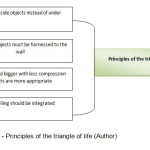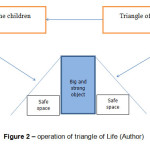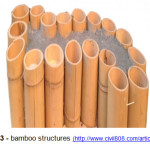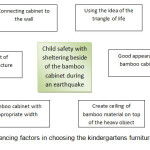Study of Safe Design Against Earthquake with the Furniture in Kindergarten, Based on the Idea of the Triangle of Life
Marzieh Sadat Ahmadnejad 1 * and Maryam Darbandi 2
1
Art University,
Iran
2
University of Tehran,
Iran
Corresponding author Email: m.arc@ahmadnejad.ir
DOI: http://dx.doi.org/10.12944/CWE.10.Special-Issue1.100
Kindergartens are one of the most vulnerable areas against the earthquake, because of the age of users and lack of training them to seek shelter in this event. Create safe shelters for children in kindergartens, is one of the most important design requirements that is ignored in the construction of this important space. Since most of the kindergartens are spaces that converted from another usage, so some solutions should be considered for kindergartens status quo to be safe against earthquake. The purpose of this search is establishing practical guidelines for the safety of child care spaces, as one of the most dangerous places against earthquake. The research questions that arise are:
1) how can make safe the kindergartens againstearthquake?
2) Can kindergartens be secure against earthquakes for users of these spaces, children, withuse
of furniture?
To answer these questions,first the idea of the triangle of life, have studied and analyzed the relationship between furniture and it. The research method used in this study, is library method according the study of the available samples. The results show that we can get maximum safety against this natural disaster rely on the idea of the triangle of life and using specific materials of furniture in kindergartens with training the children along playing haw to seek shelter during an earthquake within each class, and in the nearest possible space.
Copy the following to cite this article:
Ahmadnejad M. S, Darbandi M. Study of Safe Design Against Earthquake with the Furniture in Kindergarten, Based on the Idea of the Triangle of Life. Special Issue of Curr World Environ 2015;10(Special Issue May 2015). DOI:http://dx.doi.org/10.12944/CWE.10.Special-Issue1.100
Copy the following to cite this URL:
Ahmadnejad M. S, Darbandi M. Study of Safe Design Against Earthquake with the Furniture in Kindergarten, Based on the Idea of the Triangle of Life. Special Issue of Curr World Environ 2015;10(Special Issue May 2015). Available from: http://www.cwejournal.org?p=746/
Download article (pdf) Citation Manager Publish History
Select type of program for download
| Endnote EndNote format (Mac & Win) | |
| Reference Manager Ris format (Win only) | |
| Procite Ris format (Win only) | |
| Medlars Format | |
| RefWorks Format RefWorks format (Mac & Win) | |
| BibTex Format BibTex format (Mac & Win) |
Article Publishing History
| Received: | 2015-03-15 |
|---|---|
| Accepted: | 2015-03-26 |
Introduction
Since the spaces that children are the only users, consider as the most vulnerable spaces against earthquake, so need to think accurate and at the same time, practical about the safety of these spaces.
The purpose of this research is creating practical solutions for the safety of kindergartens. The research questions that arise are:
1) How can make safe the kindergartens against earthquake?
2) Can kindergartens be secure against earthquakes for users of these spaces, children, with use of furniture??
Research Methodology
The research method used in this study, is library method according the study of the available samples.
Analyzing the Idea
Triangle of Life
Nowadays most recommended persons take shelter under the table or door frame during earthquake, But according to the simulation experiments it has been determined, When building collapses and the roof comes down, tables are crushed and pressed, Thus, those who have taken shelter under tables lose their lives too. Also door frames are crooked either on the inside or the outside and those below them lose their lives.
Objects such as desktop and benches are unable to bear the weight of a building. These devices are designed to hold small objects and it is clear that such fragile items crush and so those below them lose their lives (Lengeh Port Safety and Firefighting Brochure, 2010).
When the buildings are destroyed, the weight that comes down on objects and furniture, crush them fatally and creates an empty space next to them. This space is what is said the “triangle of life”.
Whatever the size of the objects become larger and stronger and less compressed, the empty space increases so the probability of survival of those that refuge to, increases (http://www.wikipedia.org).
 |
|
Furniture As Resistant and Secure Object
The simulation experiments show that if we refuge under the things at the time of the earthquake, surely we will be sentenced to death, because of crushing the objects and under the heavy debris.
Observations and experiments after the earthquake show that sheltering beside heavy objects and incompressible, would be the perfect solution to seek shelter in the earthquake. (http://www.earthquakesolutions.com/id44.html)
In the kindergarten, these heavy objects could be the cupboards of children instruments that have been fully harness connected to wall. (If cupboards don’t be connected, will be the most dangerous objects)
 |
Figure 2: operation of triangle of Life (Author) Click here to View figure |
The Use of Bamboo As A Recommended Material to Resist the Collapsed Debris
As mentioned above, the material of furniture will be very effective in the survival rate of those who take refuge on its side. In the quest to achieve a suitable material, we found "Bamboo".
Tensile strength of bamboo is such as steel, and the compressive strength is like concrete while the weight of bamboo is about 0/1 of the weight of steel.
Stability with low weight makes the certain structure against natural disasters such as earthquake. The approach of author for the kindergartens is using of bamboo to build the cabinets of class.
Thus, whit the low weight bamboo materials, cabinets can be low cost and lightweight construction. After building the cabinets, they should be completely connected to the wall.
With the creation of cabinets with appropriate width and harness them to the wall in addition to good and natural bamboo appearance and light structure in classes of kindergarten, would be that in addition to the idea of resisting earthquake forces, also from other sights the bamboo is acceptable as proposed material.
 |
Figure 3: bamboo structures (http://www.civil808.com/article/ac/959) Click here to View figure |
The Proposed Structure for Integrating the Ceiling of Bamboo Cabinet
According to the one of the basic points for the formation of the triangle of life next to the object, is the existence of integrated roof above object, The author proposes the use of bamboo wood as additional structure top of the solid and heavy object (here: bamboo cabinets). These structures can be attached to the ceiling structure. (Ceiling should be integrated with the bamboo roof.)
In this case, according to the integrity of the roof, collapsed debris doesn’t crush and at the time of earthquake, collapse as a piece and this creates the triangle of life besides bamboo cabinet.
 |
|
Conclusion
The results suggest that in the kindergarten that are the most vulnerable areas at the time of the earthquake can make security spaces rely on the idea of the triangle of life, and the use of materials of bamboo as a fit, strong and incompressible material, for kindergartens furniture and part of the roof, and with a lot easier teaching children to seek shelter in emergencies. In addition, bamboo material as an organic and nature friendly material will have also the role of sense of heat to the environment.
References
- Lengeh Port Safety and Firefighting Brochure (2010)
- http://www.wikipedia.org
- http://www.earthquakesolutions.com/id44.html
- http://www.civil808.com/article/ac/959
- Yazdi, mohammad, bamboo structure Connectors, recorded at Esfahan Scientific and Industrial Research Organization, (2011)
- Edmond A. Mathez, James D. Webster, The Earth Machine: The Science of a Dynamic Planet, Columbia University Press,( 2004)
- Michael Pacione, Applied Geography: Principles and Practice: an Introduction to Useful Research in Physical, Environmental and Human Geography, Routledge, (1999)







